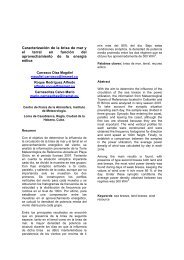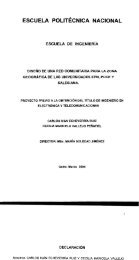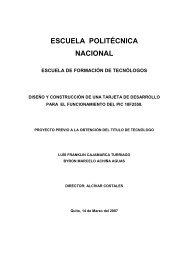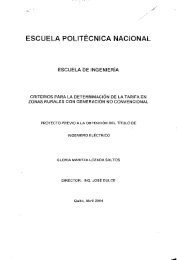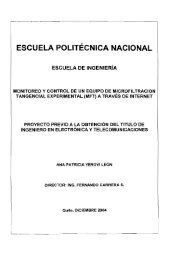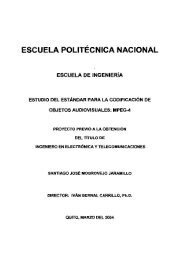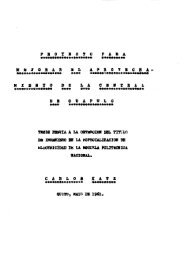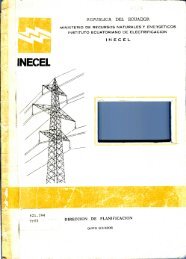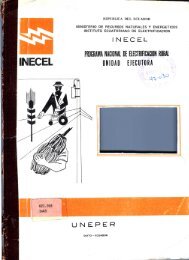Tesis previa a la obtención del Título de Ingeniero en Electrónica y ...
Tesis previa a la obtención del Título de Ingeniero en Electrónica y ...
Tesis previa a la obtención del Título de Ingeniero en Electrónica y ...
You also want an ePaper? Increase the reach of your titles
YUMPU automatically turns print PDFs into web optimized ePapers that Google loves.
The voice signal will be carried in the initial connection and ví<strong>de</strong>o, graphics and auxiliary data may be carried in the<br />
initial and/or other connections.<br />
10.3.4 n X H0 operation<br />
In n X HQ operation, each connection will he framed separately and differ<strong>en</strong>t<strong>la</strong>l <strong>de</strong><strong>la</strong>y betwe<strong>en</strong> the channels will be<br />
comp<strong>en</strong>sated accordíng to Recomm<strong>en</strong>dation H.221.<br />
10.3.5 Dynamic allocation within a primary-rate connection<br />
Intellig<strong>en</strong>t termináis may have a means for dynamically increasing or <strong>de</strong>creasing the bit rate during a connection. The<br />
means for controlling these allocations will be performed according to Recomm<strong>en</strong>dation H.221. There may be a need to<br />
recover framing by extractíon from the received signal in<strong>de</strong>p<strong>en</strong><strong>de</strong>ntly.<br />
10.4 Interworking betwe<strong>en</strong> 56 kbit/s and 64 kbit/s termináis<br />
In the worst case it must he assumed that neither terminal is aware (by means of a D-channel message or otherwise)<br />
that it is connected to a terminal of the other type; furthermore septet timing cannot be assumed at the 56 kbit/s <strong>en</strong>d. At<br />
the 64 kbít/s <strong>en</strong>d, byte timíng is indisp<strong>en</strong>sable, since without this it cannot be known which bit (1 in every 8) will not be<br />
transmitted to the remote <strong>en</strong>d (see Figure 2, outcome IV).<br />
Initially, terminal X (at 64 kbií/s) transmits FAS and capability-BAS on bit 8, on the false assumption that the remote<br />
terminal ís also at 64 kbit/s. Frame search is carried out on the whole incoming signal; clearly, searching only on bit 8<br />
will result in outcome II (see Figure 2).<br />
If frame alignm<strong>en</strong>t is found, and this may be in any bit posítion, giv<strong>en</strong> the <strong>la</strong>ck of septet timing at the other <strong>en</strong>d, th<strong>en</strong><br />
the fact of interworking with a 56 kbit/s terminal immediately becomes known from the capability BAS, which terminal<br />
Y must inclu<strong>de</strong> in its capability BAS cycle. Terminal X immediately changes to transmhting FAS and BAS on bit 7,<br />
since bit 8 is the one whích is not transmitted through the restricted networks. Initialization should th<strong>en</strong> proceed as in<br />
6.1, with outcome Ib in Figure 2.<br />
In the ev<strong>en</strong>t that no frame alignm<strong>en</strong>t is found in any sub-channel, outcome II of 6.1.1 applies.<br />
NOTES<br />
1 All 56 kbit/s audiovisual termináis must transmit the appropriate capability BAS (100J [22] ¡n every capability<br />
exchange.<br />
2 Unless it Ís sure that they will never be requíred to interwork with 56 kbit/s networks, termináis manufacturad for<br />
use on 64 kbit/s networks should preferably have the capability to search for frame alignm<strong>en</strong>t in all bit positíons.<br />
3 It may be advisable to mute audio output untíl incoming frame alignrn<strong>en</strong>t has be<strong>en</strong> achíeved or a switch to<br />
unframed PCM has be<strong>en</strong> <strong>de</strong>ci<strong>de</strong>d upon.<br />
10.5 Interworking betwe<strong>en</strong> HQ or HU termináis in restricted and unrestricted networks<br />
At the start of the communication, the terminal on the restricted network transmits framed signáis with the service<br />
channel in.bit 7 of the I-channel and all "1 "s in bit 8 of every time-slot; the restricted capability BAS (100) [22] is s<strong>en</strong>t.<br />
In the terminal on the unrestricted network, frame search is carried out on the whole incoming signal (or incoming TSI<br />
if synchronizatíon betwe<strong>en</strong> H0/Hn framing and H.221 framing is maintained). Wh<strong>en</strong> BAS (100) [22] Ís <strong>de</strong>tected, a<br />
terminal immediately shifts the outgoíng service channel to bit 7 and sets all "l"s on bit 8 of every time-slot.<br />
It should be noted that the re<strong>la</strong>tive posítion betwe<strong>en</strong> received FAS and stuffing T Ís fixed for the restricted HQ/H ¡ i<br />
or 128/192/256/512/768/1152/1472 kbit/s case, while it is variable for the 56 kbit/s case (see Annex B/H.221).<br />
All termináis int<strong>en</strong><strong>de</strong>d for interworking with termináis connected to restricted networks must be capahle of performing<br />
thís procedure.<br />
11 Procedure for use of BAS-ext<strong>en</strong>sion co<strong>de</strong>s<br />
Recomm<strong>en</strong>dation H.221 provi<strong>de</strong>s for the attribute (111) for ext<strong>en</strong>sión of the use of the BAS position in the subsequ<strong>en</strong>t<br />
sub-multlframe(s) for other purposes. There are 32 valúes of this attribute, the meanings of these being <strong>de</strong>fined in



